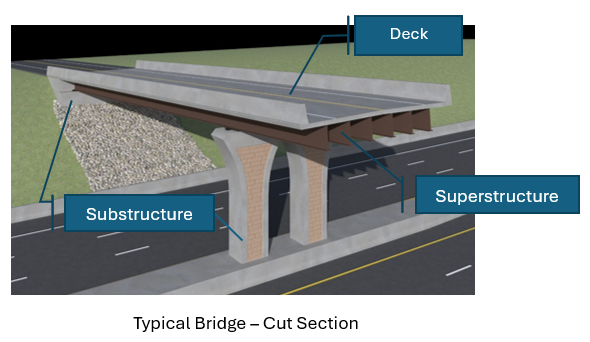"Poor" Rated Bridges
"Poor" Rated Bridges on the Maryland State Highway System

The overall condition of a bridge is categorized into good, fair, and poor based on an evaluation of the bridge during inspections that occur a minimum of every two years. The main features that go into a bridge’s rating are:
-
the deck (riding surface);
-
the superstructure (main supporting element of the deck, usually beams, girders, trusses, etc.)
- the substructure (supports to hold up the superstructure and deck, usually abutments and piers).
The Maryland Department of Transportation State Highway Administration (SHA) rates each feature from zero (closed to through traffic) to nine (nearly new). If any of these features are rated four or below, federal standards require that the bridge is rated poor. The poor rating is an early warning sign for engineers to prioritize funding and initiate preservation and/or rehabilitation efforts or to replace the bridge.
Note
This does not mean that the bridge is unsafe.
If a bridge becomes unsafe, it will be closed.
The summary below is from the annual SHA submission to the Federal Highway Administration (FHWA) made in March 2025. It reports that there are 2,574 bridges on the Maryland State Highway System, of which 20, or about 1%, are rated as poor. The number of “poor” rated bridges decreased from 143 in 2005 to 20 in 2025.
Summary for 2025
| |
|---|
| Number of Poor Rated Bridges submitted to FHWA on March 15, 2024 | 22
|
| Number of Poor Rated bridges addressed in 2024 | 2 |
| SUBTOTAL | 20 |
| Number of bridges that became Poor Rated in the 2025 submission to FHWA | 0 |
Total number of Poor Rated Bridges submitted to FHWA on March 15, 2025
| 20
|
Prior to 2018, FHWA used the term “Poor Rated” to identify bridges rated as poor. FHWA no longer uses this designation. The structurally deficient rating is like the poor rating; it included bridges where one of the main elements is rated four or less, but also included criteria involving a bridge’s structural load carrying capacity and hydraulic adequacy.